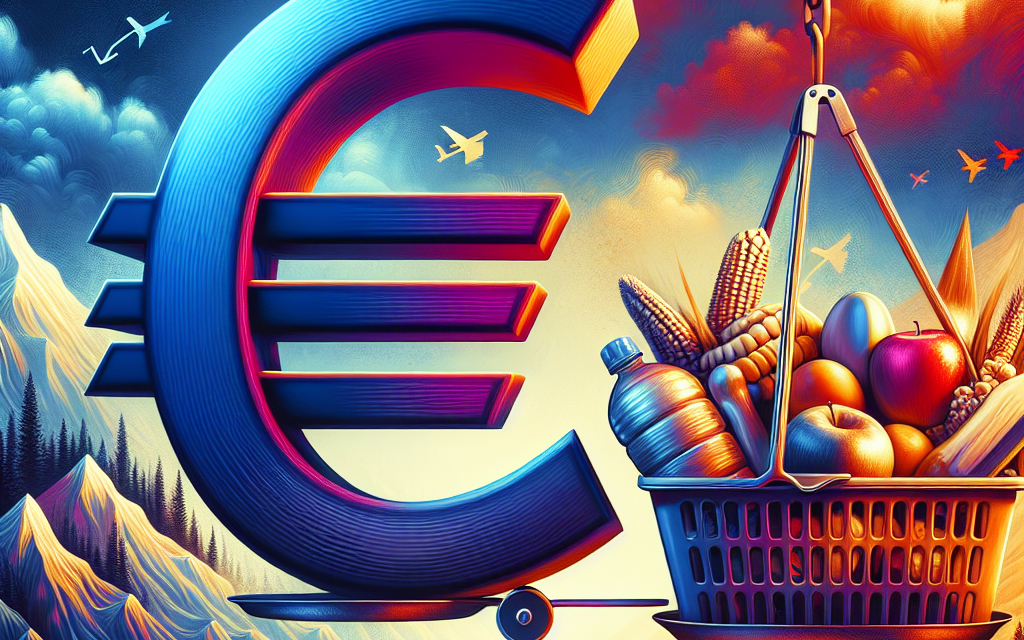“Eurozone Inflation Soars Past ECB Target, Raising Economic Concerns.”
Introduction
Eurozone inflation has surged beyond the European Central Bank’s (ECB) target once again, raising concerns among policymakers and economists alike. This resurgence in inflationary pressures is attributed to a combination of factors, including rising energy prices, supply chain disruptions, and increased consumer demand as economies recover from the impacts of the COVID-19 pandemic. The ECB, which aims to maintain inflation at around 2%, faces the challenge of balancing economic growth with the need to control rising prices. As inflation rates climb, discussions surrounding monetary policy adjustments and their potential implications for the Eurozone economy are becoming increasingly urgent.
Eurozone Inflation Trends: Analyzing Recent Surges
In recent months, the Eurozone has witnessed a notable surge in inflation, surpassing the European Central Bank’s (ECB) target of 2%. This development has raised significant concerns among policymakers, economists, and consumers alike, as it reflects broader economic dynamics that could have lasting implications for the region. To understand the current inflation trends, it is essential to analyze the underlying factors contributing to this phenomenon and the potential consequences for the Eurozone’s economic landscape.
One of the primary drivers of the recent inflation surge has been the persistent increase in energy prices. Following the global recovery from the COVID-19 pandemic, demand for energy has rebounded sharply, leading to heightened competition for resources. This situation has been exacerbated by geopolitical tensions, particularly in Eastern Europe, which have further strained supply chains and contributed to rising costs. As energy prices climb, they inevitably influence the overall price level, affecting not only transportation and manufacturing but also household expenses. Consequently, consumers are feeling the pinch, as their purchasing power diminishes in the face of escalating costs.
In addition to energy prices, supply chain disruptions have played a significant role in the inflationary pressures observed in the Eurozone. The pandemic exposed vulnerabilities in global supply chains, leading to delays and shortages of essential goods. As economies reopened, the surge in demand collided with these supply constraints, resulting in increased prices for a wide array of products. This phenomenon is particularly evident in sectors such as automotive and electronics, where semiconductor shortages have led to production slowdowns and, subsequently, higher prices for consumers. The interplay between demand recovery and supply chain challenges has created a perfect storm for inflation, complicating the ECB’s efforts to maintain price stability.
Moreover, labor market dynamics have also contributed to the inflationary environment. As businesses strive to attract and retain talent in a competitive labor market, wage growth has become more pronounced. While higher wages can be beneficial for workers, they can also lead to increased production costs for companies, which may subsequently pass these costs onto consumers in the form of higher prices. This wage-price spiral poses a challenge for the ECB, as it must balance the need for economic growth with the imperative to control inflation.
In light of these developments, the ECB faces a complex decision-making landscape. On one hand, the central bank must consider tightening monetary policy to combat rising inflation; on the other hand, such measures could stifle economic recovery and hinder growth. The delicate balance between these competing priorities underscores the challenges faced by policymakers in navigating the current economic environment. As inflation continues to exceed the ECB’s target, the central bank’s credibility and effectiveness in managing price stability will be put to the test.
In conclusion, the recent surge in Eurozone inflation reflects a confluence of factors, including rising energy prices, supply chain disruptions, and labor market dynamics. As these trends unfold, the implications for consumers and businesses are profound, necessitating careful consideration by policymakers. The ECB’s response will be crucial in shaping the economic trajectory of the Eurozone, as it seeks to restore price stability while fostering sustainable growth. As the situation evolves, stakeholders will be closely monitoring developments, aware that the path forward will require a nuanced understanding of the intricate interplay between inflationary pressures and economic recovery.
Impact of Inflation on Eurozone Economies
The recent surge in inflation across the Eurozone has raised significant concerns among economists, policymakers, and consumers alike. As inflation rates climb beyond the European Central Bank’s (ECB) target of around 2%, the implications for Eurozone economies become increasingly complex and multifaceted. This situation not only affects the purchasing power of consumers but also poses challenges for businesses and the overall economic stability of the region.
To begin with, the most immediate impact of rising inflation is felt by consumers, who experience a decrease in their purchasing power. As prices for essential goods and services, such as food, energy, and housing, continue to rise, households find themselves grappling with tighter budgets. This situation is particularly challenging for low- and middle-income families, who spend a larger proportion of their income on necessities. Consequently, as disposable income shrinks, consumer confidence may wane, leading to reduced spending. This decline in consumption can create a ripple effect throughout the economy, as businesses may respond to decreased demand by cutting back on production, delaying investments, or even laying off workers.
Moreover, the impact of inflation extends beyond individual households to the broader business landscape. Companies face rising costs for raw materials, labor, and transportation, which can erode profit margins. In response, businesses may be compelled to pass these costs onto consumers in the form of higher prices, further fueling inflation. This cycle can create a challenging environment for businesses, particularly small and medium-sized enterprises that may lack the financial resilience to absorb increased costs. As a result, some firms may struggle to maintain their competitive edge, leading to potential market consolidation as weaker players exit the market.
In addition to these immediate effects, persistent inflation can complicate monetary policy for the ECB. The central bank’s primary mandate is to maintain price stability, and when inflation consistently exceeds its target, it may be forced to take action. This could involve raising interest rates to curb inflationary pressures. However, higher interest rates can also have adverse effects on economic growth, as borrowing costs increase for consumers and businesses alike. This delicate balancing act poses a significant challenge for policymakers, who must weigh the risks of stifling growth against the need to rein in inflation.
Furthermore, the implications of rising inflation are not uniform across the Eurozone. Different member states may experience varying levels of inflation due to factors such as local economic conditions, labor market dynamics, and energy prices. For instance, countries heavily reliant on energy imports may face more pronounced inflationary pressures, while those with stronger domestic production capabilities may be better positioned to mitigate the impact. This divergence can lead to increased economic disparities within the Eurozone, complicating efforts to achieve a cohesive monetary policy.
In conclusion, the surge in inflation beyond the ECB’s target has far-reaching implications for Eurozone economies. From the erosion of consumer purchasing power to the challenges faced by businesses and the complexities of monetary policy, the effects of rising inflation are profound and multifaceted. As the situation continues to evolve, it will be crucial for policymakers to navigate these challenges carefully, ensuring that measures taken to address inflation do not inadvertently stifle economic growth or exacerbate inequalities within the region. The path forward will require a nuanced understanding of the interconnectedness of these factors and a commitment to fostering stability in the Eurozone economy.
ECB’s Response to Rising Inflation Rates
As inflation rates in the Eurozone continue to surge beyond the European Central Bank’s (ECB) target, the institution faces mounting pressure to respond effectively to this economic challenge. The ECB’s primary mandate is to maintain price stability, which it defines as an inflation rate of around 2%. However, recent data indicates that inflation has consistently exceeded this benchmark, prompting concerns about the potential long-term implications for the Eurozone economy. In light of these developments, the ECB has been compelled to reassess its monetary policy strategies to address the rising inflation rates.
In response to the persistent inflationary pressures, the ECB has signaled a shift in its approach to interest rates. Traditionally, the central bank has utilized low interest rates as a tool to stimulate economic growth. However, with inflation now outpacing expectations, the ECB is considering a gradual tightening of its monetary policy. This shift is aimed at curbing inflation by making borrowing more expensive, thereby reducing consumer spending and investment. The central bank’s decision to potentially raise interest rates reflects a balancing act between fostering economic growth and maintaining price stability.
Moreover, the ECB has also indicated that it may taper its asset purchase program, which has been a cornerstone of its monetary policy since the onset of the COVID-19 pandemic. By reducing the scale of asset purchases, the ECB aims to decrease the liquidity in the financial system, which could help to alleviate some of the inflationary pressures. This strategy, however, is not without its risks. A premature withdrawal of monetary support could stifle the economic recovery, particularly in sectors that are still grappling with the aftereffects of the pandemic. Therefore, the ECB must carefully evaluate the timing and magnitude of any adjustments to its asset purchase program.
In addition to interest rate hikes and tapering asset purchases, the ECB is also closely monitoring external factors that contribute to inflation. Supply chain disruptions, energy price fluctuations, and geopolitical tensions have all played significant roles in driving up prices across the Eurozone. The central bank recognizes that these factors are often beyond its control, yet it remains committed to addressing the domestic economic conditions that exacerbate inflation. By maintaining open lines of communication with other economic institutions and governments, the ECB aims to foster a coordinated response to these challenges.
Furthermore, the ECB’s communication strategy has become increasingly important in managing market expectations. By clearly articulating its policy intentions and the rationale behind its decisions, the central bank seeks to instill confidence among investors and consumers. This transparency is crucial in an environment where uncertainty can lead to volatility in financial markets. As the ECB navigates this complex landscape, it must strike a delicate balance between being proactive in its response to inflation while also ensuring that its actions do not undermine the fragile economic recovery.
In conclusion, the ECB’s response to rising inflation rates is multifaceted, involving potential interest rate hikes, adjustments to asset purchases, and a keen awareness of external economic factors. As the central bank grapples with the challenges posed by persistent inflation, its ability to communicate effectively and implement measured policy changes will be critical in maintaining price stability and supporting the Eurozone’s economic recovery. The path forward will require careful consideration of both immediate and long-term implications, as the ECB seeks to navigate this evolving economic landscape.
Consumer Behavior Amidst Inflation in the Eurozone
As inflation in the Eurozone continues to surge beyond the European Central Bank’s (ECB) target, consumer behavior is undergoing significant transformations. The persistent rise in prices has prompted individuals and households to reassess their spending habits, leading to a shift in consumption patterns that reflects both immediate concerns and long-term adjustments. This evolving landscape of consumer behavior is crucial for understanding the broader economic implications of sustained inflationary pressures.
To begin with, the most immediate response to rising inflation is often a tightening of household budgets. Consumers are increasingly prioritizing essential goods and services, such as food, housing, and utilities, while discretionary spending on non-essential items is being curtailed. This shift is evident in various sectors, with retailers reporting a decline in sales of luxury goods and a corresponding increase in demand for budget-friendly alternatives. As consumers become more price-sensitive, they are more likely to seek out discounts, shop at lower-cost retailers, and utilize loyalty programs to maximize their purchasing power.
Moreover, the impact of inflation is not uniform across different demographics. For instance, lower-income households tend to feel the effects of rising prices more acutely, as a larger proportion of their income is allocated to essential expenditures. Consequently, these households may resort to more drastic measures, such as reducing their overall consumption or seeking additional sources of income. In contrast, higher-income consumers may have more flexibility to absorb price increases, yet they too are becoming more discerning in their purchasing decisions. This divergence in consumer behavior highlights the complex interplay between income levels and inflationary pressures, underscoring the need for targeted policy responses.
In addition to altering spending habits, inflation is also influencing consumer sentiment and expectations. As prices continue to rise, many consumers express concerns about the future economic landscape, leading to a more cautious outlook. This shift in sentiment can create a feedback loop, where reduced consumer confidence results in lower spending, which in turn can slow economic growth. Furthermore, as consumers anticipate continued inflation, they may adjust their purchasing behavior by buying in bulk or stockpiling goods, further exacerbating supply chain challenges and contributing to price volatility.
Transitioning from immediate responses to longer-term adjustments, it is essential to consider how inflation is reshaping consumer preferences. As individuals become more aware of the implications of rising prices, there is a growing interest in sustainable and value-driven consumption. Consumers are increasingly inclined to support local businesses and prioritize products that offer long-term value, rather than succumbing to the allure of cheap, disposable goods. This shift not only reflects a desire for quality but also aligns with broader societal trends toward sustainability and ethical consumption.
In conclusion, the surge in inflation within the Eurozone is prompting significant changes in consumer behavior, characterized by a heightened focus on essential spending, a cautious outlook on future economic conditions, and a shift toward sustainable consumption practices. As these trends continue to evolve, they will undoubtedly shape the economic landscape in the region, influencing everything from retail strategies to policy decisions. Understanding these behavioral shifts is essential for businesses and policymakers alike, as they navigate the complexities of an inflationary environment and seek to foster resilience in the face of ongoing economic challenges.
Sector-Specific Effects of Inflation in the Eurozone
The recent surge in inflation within the Eurozone has raised significant concerns, particularly as it surpasses the European Central Bank’s (ECB) target of around 2%. This inflationary pressure is not uniform across the economy; rather, it manifests differently across various sectors, each responding uniquely to the prevailing economic conditions. Understanding these sector-specific effects is crucial for policymakers, businesses, and consumers alike, as they navigate the complexities of an inflationary environment.
In the energy sector, for instance, the impact of inflation has been particularly pronounced. Rising global energy prices, exacerbated by geopolitical tensions and supply chain disruptions, have led to increased costs for both producers and consumers. As energy prices climb, businesses face higher operational costs, which can lead to reduced profit margins. Consequently, many companies may pass these costs onto consumers, further fueling inflation. This cycle creates a challenging environment for households, particularly those with lower incomes, who may struggle to absorb these rising expenses.
Similarly, the food sector has experienced significant inflationary pressures. Factors such as adverse weather conditions, supply chain bottlenecks, and increased transportation costs have contributed to rising food prices across the Eurozone. As consumers face higher grocery bills, their purchasing power diminishes, leading to changes in consumption patterns. Many households may opt for cheaper alternatives or reduce their overall food expenditure, which can have long-term implications for food producers and retailers. This shift not only affects demand but also influences the pricing strategies of businesses, as they seek to balance profitability with consumer affordability.
The manufacturing sector is also feeling the effects of inflation, particularly in terms of raw material costs. As prices for essential inputs rise, manufacturers are confronted with the challenge of maintaining production levels while managing increased expenses. This situation can lead to a slowdown in production, as companies may be forced to scale back operations or delay investments in new technologies. Furthermore, the uncertainty surrounding inflation can hinder long-term planning, as businesses grapple with fluctuating costs and unpredictable market conditions.
In contrast, the services sector has shown a more varied response to inflation. While some service providers, particularly in hospitality and tourism, have struggled with rising costs and reduced consumer spending, others have managed to adapt by increasing prices. For instance, businesses in the leisure and entertainment industries may find that consumers are willing to pay a premium for experiences, even in the face of rising costs. This divergence highlights the importance of sector-specific dynamics in understanding the broader implications of inflation.
Moreover, the financial sector is not immune to the effects of inflation. Rising interest rates, a common response to inflationary pressures, can impact borrowing costs for consumers and businesses alike. As loans become more expensive, there may be a slowdown in investment and consumer spending, which can further dampen economic growth. Additionally, the volatility in financial markets can create uncertainty, prompting investors to reassess their strategies in light of changing economic conditions.
In conclusion, the sector-specific effects of inflation in the Eurozone illustrate the complexity of the current economic landscape. Each sector faces unique challenges and opportunities as they navigate rising prices and shifting consumer behavior. Understanding these dynamics is essential for stakeholders across the economy, as they seek to adapt to an environment characterized by persistent inflation and its far-reaching consequences. As the ECB continues to monitor these developments, the interplay between inflation and sectoral performance will remain a critical area of focus for policymakers and economic analysts alike.
Future Projections for Eurozone Inflation
As the Eurozone grapples with persistent inflationary pressures, future projections indicate a complex landscape that policymakers must navigate. Recent data has shown inflation rates surging beyond the European Central Bank’s (ECB) target of 2%, raising concerns about the sustainability of economic recovery in the region. Analysts suggest that several factors will influence the trajectory of inflation in the coming months, including energy prices, supply chain disruptions, and labor market dynamics.
To begin with, energy prices remain a significant driver of inflation in the Eurozone. The volatility in global energy markets, exacerbated by geopolitical tensions and supply constraints, has led to fluctuating costs for consumers and businesses alike. As energy prices continue to rise, they contribute to higher production costs, which are often passed on to consumers in the form of increased prices for goods and services. Consequently, if energy prices remain elevated or experience further spikes, it is likely that inflation will persist above the ECB’s target, complicating the central bank’s monetary policy decisions.
In addition to energy costs, supply chain disruptions have played a crucial role in shaping inflationary trends. The COVID-19 pandemic exposed vulnerabilities in global supply chains, leading to delays and shortages of essential goods. As economies reopen and demand surges, these supply chain bottlenecks have not fully resolved, resulting in increased costs for manufacturers and retailers. This situation is further compounded by labor shortages in various sectors, which can lead to wage inflation as companies compete for a limited pool of workers. If these supply chain issues continue, they could sustain upward pressure on prices, making it challenging for the ECB to achieve its inflation target.
Moreover, the labor market dynamics within the Eurozone will also be pivotal in determining future inflation rates. As unemployment rates decline and job vacancies increase, wage growth may accelerate. While rising wages can enhance consumer purchasing power, they can also contribute to inflation if businesses raise prices to offset higher labor costs. Therefore, the interplay between wage growth and inflation will be a critical factor for the ECB to monitor closely. If wage increases outpace productivity gains, it could lead to a wage-price spiral, further entrenching inflationary pressures.
In light of these factors, the ECB faces a delicate balancing act. On one hand, the central bank must consider tightening monetary policy to combat rising inflation; on the other hand, it must ensure that such measures do not stifle economic growth or recovery. The recent trend of rising interest rates reflects the ECB’s commitment to addressing inflation, yet the timing and magnitude of such adjustments will be crucial. If the central bank acts too aggressively, it risks derailing the fragile recovery, while a more cautious approach may allow inflation to become entrenched.
Looking ahead, economists predict that inflation in the Eurozone will remain elevated in the near term, with projections suggesting that it may take longer than anticipated for rates to return to the ECB’s target. As the central bank navigates this challenging environment, it will need to remain vigilant and responsive to evolving economic conditions. Ultimately, the future of Eurozone inflation will depend on a confluence of factors, including energy prices, supply chain stability, and labor market trends, all of which will shape the economic landscape in the months and years to come.
Comparing Eurozone Inflation with Global Trends
In recent months, Eurozone inflation has surged beyond the European Central Bank’s (ECB) target, prompting a closer examination of its implications in the context of global economic trends. As inflationary pressures mount across various regions, it becomes essential to compare the Eurozone’s situation with that of other economies, particularly those in North America and Asia. This comparative analysis not only highlights the unique challenges faced by the Eurozone but also underscores the interconnectedness of global markets.
To begin with, the Eurozone has experienced a notable increase in inflation rates, driven by a combination of factors including supply chain disruptions, rising energy prices, and increased consumer demand as economies emerge from pandemic-related restrictions. In contrast, the United States has also grappled with similar inflationary pressures, yet the Federal Reserve’s response has been markedly different. While the ECB has been cautious in its approach to tightening monetary policy, the Federal Reserve has implemented a series of aggressive interest rate hikes aimed at curbing inflation. This divergence in policy responses raises questions about the effectiveness of the ECB’s strategy in managing inflation expectations within the Eurozone.
Moreover, when examining inflation trends in Asia, particularly in countries like China and Japan, a different narrative emerges. China has faced its own set of challenges, including sporadic lockdowns and a slowing economy, which have contributed to lower inflation rates compared to the Eurozone. In Japan, the long-standing battle with deflation has led to a unique economic environment where inflation remains subdued despite global trends. This contrast highlights the varying economic conditions and policy frameworks that influence inflation across different regions, emphasizing that the Eurozone’s inflationary surge is not merely an isolated phenomenon but part of a broader global landscape.
Transitioning to the implications of these trends, it is crucial to consider how the Eurozone’s inflationary pressures may affect its economic recovery. As prices rise, consumer purchasing power diminishes, potentially leading to a slowdown in economic growth. This scenario is particularly concerning given that many Eurozone countries are still recovering from the economic fallout of the COVID-19 pandemic. In this context, the ECB faces a delicate balancing act: it must navigate the fine line between controlling inflation and supporting economic recovery. The decisions made by the ECB will not only impact the Eurozone but may also reverberate through global markets, influencing investor sentiment and capital flows.
Furthermore, the interconnectedness of global supply chains means that inflationary pressures in one region can have cascading effects elsewhere. For instance, if the Eurozone continues to experience high inflation, it may lead to increased demand for imports from other regions, thereby exacerbating inflationary trends globally. Conversely, if other economies manage to stabilize their inflation rates, it could provide some relief to the Eurozone by stabilizing prices for imported goods.
In conclusion, the surge in Eurozone inflation beyond the ECB’s target is a multifaceted issue that warrants careful consideration in the context of global economic trends. By comparing the Eurozone’s situation with that of other regions, it becomes evident that inflation is not merely a localized challenge but a global concern that requires coordinated responses. As policymakers navigate these turbulent waters, the lessons learned from both domestic and international experiences will be crucial in shaping effective strategies to address inflation while fostering sustainable economic growth.
Q&A
1. **What is the current inflation rate in the Eurozone?**
– The current inflation rate in the Eurozone has surged to 5.3%.
2. **What is the European Central Bank’s (ECB) target inflation rate?**
– The ECB’s target inflation rate is set at 2%.
3. **What factors are contributing to the rise in inflation in the Eurozone?**
– Contributing factors include rising energy prices, supply chain disruptions, and increased consumer demand.
4. **How is the ECB responding to the inflation surge?**
– The ECB is considering tightening monetary policy, including potential interest rate hikes.
5. **What impact does high inflation have on consumers in the Eurozone?**
– High inflation erodes purchasing power, leading to increased costs for goods and services.
6. **Are there any specific sectors most affected by the inflation surge?**
– Yes, sectors such as energy, food, and housing are particularly affected by rising prices.
7. **What are the long-term implications of sustained high inflation for the Eurozone economy?**
– Sustained high inflation could lead to reduced economic growth, increased borrowing costs, and potential instability in financial markets.
Conclusion
Eurozone inflation has once again exceeded the European Central Bank’s target, highlighting persistent price pressures driven by factors such as rising energy costs, supply chain disruptions, and increased consumer demand. This situation poses challenges for monetary policy, as the ECB may need to consider tightening measures to curb inflation while balancing the risk of stifling economic growth. The ongoing inflationary trend underscores the complexity of the economic landscape in the Eurozone and the need for careful policy responses to ensure stability.





